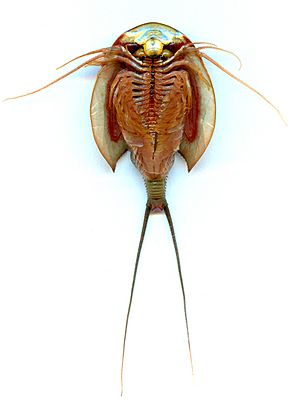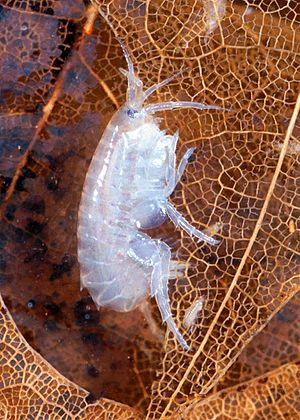List of crustaceans of Montana facts for kids
Did you know that Montana is home to at least 30 different kinds of crustaceans? These amazing creatures are a big part of the natural world, and some are even considered "Species of Concern" by the Montana Department of Fish, Wildlife and Parks. This means they need special attention to make sure their populations stay healthy.
Contents
What are Crustaceans?
Crustaceans are a huge group of animals that belong to the arthropod family, just like insects and spiders. You might know some of them, like crabs, lobsters, crayfish, shrimp, and even tiny barnacles. There are over 50,000 different types of crustaceans known around the world! They come in all sizes, from super tiny ones that are less than a millimeter long to the giant Japanese spider crab with legs that can stretch over 12 feet!
Cool Features of Crustaceans
Like all arthropods, crustaceans have a hard outer shell called an exoskeleton. This shell acts like armor, protecting their soft bodies. As they grow bigger, they have to shed this old shell in a process called molting. It's like taking off a too-small suit of clothes!
Crustaceans are special because they have unique "two-parted" limbs, which are called biramous limbs. Also, most crustaceans start their lives as tiny larvae called nauplius larvae. These larvae look very different from the adult animals they will become.
Where Do Crustaceans Live?
Most crustaceans live in water, like oceans, rivers, and lakes. But some have adapted to live on land, such as woodlice (also known as rolly pollies!). Some crustaceans are even parasites, meaning they live on or inside other animals, like certain types of fish lice. Others, like barnacles, stay in one spot their whole lives, attached to rocks or boats.
Crustaceans have been around for a very long time! Scientists have found their fossils from as far back as the Cambrian period, which was hundreds of millions of years ago. Some, like the Triops cancriformis (a type of tadpole shrimp), are called "living fossils" because they look almost exactly the same as their ancient ancestors from the Triassic period.
Crustaceans and Us
Crustaceans are super important in the environment. Tiny ones like krill and copepods might be the most common animals on Earth by weight! They are a vital part of the food chain, providing food for many other animals. Humans also eat a lot of crustaceans. Over 10 million tons of shrimp and prawns are caught or farmed every year for people to enjoy! The scientific study of crustaceans is called carcinology, and the scientists who study them are called carcinologists.
Crustaceans of Montana
Montana is home to many different kinds of crustaceans. Here are some of the interesting ones you might find:
Malacostraca: Crabs, Lobsters, and More!
The Malacostraca class includes many familiar crustaceans like crayfish and shrimp-like creatures.
- Crayfishes: These freshwater "mini-lobsters" are common in Montana's rivers and lakes.
- Pilose crayfish (Pacifastacus gambelii)
- Signal crayfish (Pacifastacus leniusculus)
- Calico crayfish (Orconectes immunis)
- Virile crayfish (Orconectes virilis)
- Amphipods: These are small, shrimp-like crustaceans often found in water.
- Stygobromus montanensis
- Stygobromus obscurus
- Stygobromus puteanus
- Stygobromus tritus
- Glacier amphipod (Stygobromus glacialis)
- Gammarus lacustris
- Hyalella azteca
- Isopods: This group includes creatures like woodlice, but also some aquatic types.
- Salmasellus steganothrix
- Caecidotea communis
- Caecidotea racovitzai
Fairy Shrimp and Tadpole Shrimp
These are fascinating, often tiny, crustaceans that live in temporary pools of water.
- Brine Shrimp and Fairy Shrimp: These delicate creatures often live in temporary ponds that dry up. Their eggs can survive for a long time in dry soil, waiting for the next rain!
- Circumpolar fairy shrimp (Branchinecta paludosa)
- Colorado fairy shrimp (Branchinecta coloradensis)
- Giant fairy shrimp (Branchinecta gigas)
- Rock pool fairy shrimp (Branchinecta packardi)
- Versatile fairy shrimp (Branchinecta lindahli)
- Ethologist fairy shrimp (Eubranchipus serratus)
- Ornate fairy shrimp (Eubranchipus ornatus)
- Smoothlip fairy shrimp (Eubranchipus intricatus)
- Greater plains fairy shrimp (Streptocephalus texanus)
- Spinytail fairy shrimp (Streptocephalus sealii)
- Clam Shrimp: These small crustaceans have a shell that looks a bit like a tiny clam.
- Bristletail clam shrimp (Caenestheriella setosa)
- Hookleg clam shrimp (Lynceus mucronatus)
- Tadpole Shrimp: These unique crustaceans have a long tail and a shield-like shell, making them look a bit like tiny tadpoles.
- Bilobed tadpole shrimp (Lepidurus bilobatus)
- Lemon tadpole shrimp (Lepidurus lemmoni)
- Longtail tadpole shrimp (Triops longicaudatus)
- Round spine tadpole shrimp (Lepidurus couesii)
See also




